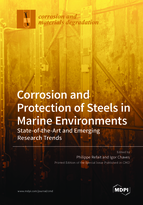Corrosion and Protection of Steels in Marine Environments: State-of-the-Art and Emerging Research Trends
A special issue of Corrosion and Materials Degradation (ISSN 2624-5558).
Deadline for manuscript submissions: closed (30 September 2021) | Viewed by 40856
Special Issue Editors
Interests: corrosion of steels in natural environments; biocorrosion; corrosion in the marine environment; cathodic protection
Special Issue Information
Dear Colleagues,
We would like to invite you to submit your work to this Special Issue on “Corrosion and Protection of Steels in Marine Environments: State-of-the-Art and Emerging Research Trends”. Marine corrosion is a very ancient topic, as humankind has, since antiquity, struggled with the corrosiveness of seawater to exploit the countless and essential natural resources of the sea. It is also a wide topic because it combines chemical, biological and mechanical factors. Among the numerous materials used for marine applications, iron-based alloys (i.e., steels) are essential in various industrial domains such as (of course) naval (ships, submarines, etc.), energy (pipelines, offshore platforms, renewable energy devices, etc.), or buildings (seaport structures, bridges, steel reinforcement in concrete, etc.). Marine corrosion is still an issue to this day because the recent and necessary development of marine renewable energy devices has motivated innovative research. Currently, complete mastery of corrosion issues is a key aspect in the profitability of produced energy. Simultaneously, requirements for environmentally friendly anticorrosion methods and processes are clearly expressed. Numerous and fundamental recent advances in marine corrosion and protection of steels, including carbon steel, low alloy steel and stainless steel, can then be noted. This Special Issue is necessary to acknowledge the recent and sudden increase in the understanding of steel corrosion processes in marine environments and the associated optimization of anticorrosion methods. Last, but not least, a large part of our cultural heritage lies at the bottom of seas and oceans, and it will definitely be lost if scientific research does not include current and historical concerns as well.
In particular, the topics of interest include, but are not limited to, the following:
- steel corrosion mechanisms in marine environments;
- biocorrosion of steels in marine environments;
- development of new alloys, stainless steels and low alloy steels;
- coatings and surface treatments for marine applications;
- cathodic protection and associated phenomena (e.g., calcareous deposition);
- methods and corrosion tests in marine environments, in situ vs laboratory experiments; and
- ancient iron artefacts, corrosion mechanisms, protection and restoration.
Prof. Dr. Philippe Refait
Dr. Igor Chaves
Guest Editors
Manuscript Submission Information
Manuscripts should be submitted online at www.mdpi.com by registering and logging in to this website. Once you are registered, click here to go to the submission form. Manuscripts can be submitted until the deadline. All submissions that pass pre-check are peer-reviewed. Accepted papers will be published continuously in the journal (as soon as accepted) and will be listed together on the special issue website. Research articles, review articles as well as short communications are invited. For planned papers, a title and short abstract (about 100 words) can be sent to the Editorial Office for announcement on this website.
Submitted manuscripts should not have been published previously, nor be under consideration for publication elsewhere (except conference proceedings papers). All manuscripts are thoroughly refereed through a single-blind peer-review process. A guide for authors and other relevant information for submission of manuscripts is available on the Instructions for Authors page. Corrosion and Materials Degradation is an international peer-reviewed open access quarterly journal published by MDPI.
Please visit the Instructions for Authors page before submitting a manuscript. The Article Processing Charge (APC) for publication in this open access journal is 1000 CHF (Swiss Francs). Submitted papers should be well formatted and use good English. Authors may use MDPI's English editing service prior to publication or during author revisions.







